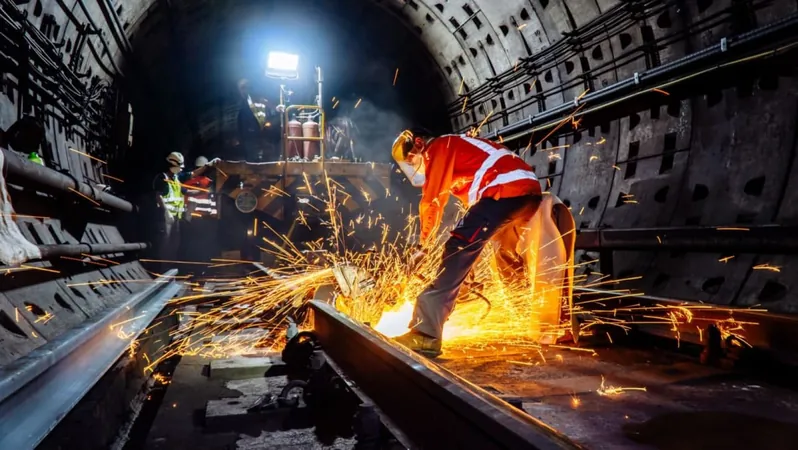
Major Overhaul Ahead: SMRT Launches Tripartite Workgroup to Bolster Rail Reliability and Safety
2024-11-01
Author: John Tan
Introduction
In a significant move to address recent service disruptions, public transport operator SMRT announced on Friday, November 1, the establishment of a tripartite workgroup aimed at reviewing the reliability and safety of its rail network. This initiative follows a troubling six-day disruption on the East-West Line—the longest train outage since 2017—which prompted concerns over service efficiency and safety among commuters.
Formation of the Workgroup
The newly formed workgroup will consist of rail sector experts from SMRT, representatives from the Land Transport Authority (LTA)—which oversees rail infrastructure—and members from the National Transport Workers’ Union (NTWU). The workgroup will be chaired by Lam Sheau Kai, president of SMRT Trains, with co-chair responsibilities held by Yee Boon Cheow, the deputy chief executive for infrastructure and development at the LTA. NTWU’s Deputy Executive Secretary, Jimmy Wee, will also play a key role.
Review Timeline and Focus Areas
In response to inquiries, an SMRT spokesperson mentioned that the final composition of the workgroup is currently being finalized and will be publicly announced soon. The review is anticipated to be completed within a six-month timeframe.
While SMRT maintains that all its MRT lines have consistently met the target of 1 million mean kilometers between failures since 2019, the new workgroup will delve deeper into existing systems and processes to sustain and enhance this reliability standard. Areas of focus will include life cycle management, asset renewal, system enhancements, and maintenance practices.
Peer Benchmarking Exercises
To facilitate improvements, the workgroup is set to conduct peer benchmarking exercises with prominent industry leaders, including the Guangzhou Metro Corporation and the Taipei Rapid Transit Corporation. This strategic approach aims to extract valuable insights from operators renowned for their world-class safety and reliability records.
Statements from Officials
An official from SMRT stated, 'The workgroup is aimed at strengthening the MRT ecosystem by addressing issues holistically from a life cycle management perspective. It also seeks to enhance capabilities and ensure close collaboration among asset owners, operators, and the workforce for long-term improvements.'
NTWU Executive Secretary Melvin Yong added that this collaborative approach takes into account the perspectives of all stakeholders, promoting a win-win-win outcome for commuters, operators, and workers alike. He emphasized the importance of incorporating workplace safety improvements through collective input rather than solely from top management.
Background of the Disruption
The six-day disruption on the East-West Line began on September 25, following a faulty train’s return to the Ulu Pandan depot, which caused a power trip and damage to both the track and adjacent equipment. This incident forced repair works to be prolonged as further damage was uncovered, with over 300 engineers and technicians mobilized for rectification efforts. Transportation Minister Chee Hong Tat noted on September 26 the scale of the repairs being undertaken.
Ongoing Investigation
In early October, the LTA launched an investigation into the incident, with results expected to be made public soon, emphasizing a commitment to transparency and safety in Singapore's extensive rail network.
Conclusion
As SMRT embarks on this crucial review, the future of rail reliability and passenger safety looks to be at the forefront of national transportation priorities, ensuring Singapore’s public transport remains a model for others to follow. Stay tuned as we uncover how this initiative evolves and impacts Singapore's commuters.




 Brasil (PT)
Brasil (PT)
 Canada (EN)
Canada (EN)
 Chile (ES)
Chile (ES)
 España (ES)
España (ES)
 France (FR)
France (FR)
 Hong Kong (EN)
Hong Kong (EN)
 Italia (IT)
Italia (IT)
 日本 (JA)
日本 (JA)
 Magyarország (HU)
Magyarország (HU)
 Norge (NO)
Norge (NO)
 Polska (PL)
Polska (PL)
 Schweiz (DE)
Schweiz (DE)
 Singapore (EN)
Singapore (EN)
 Sverige (SV)
Sverige (SV)
 Suomi (FI)
Suomi (FI)
 Türkiye (TR)
Türkiye (TR)